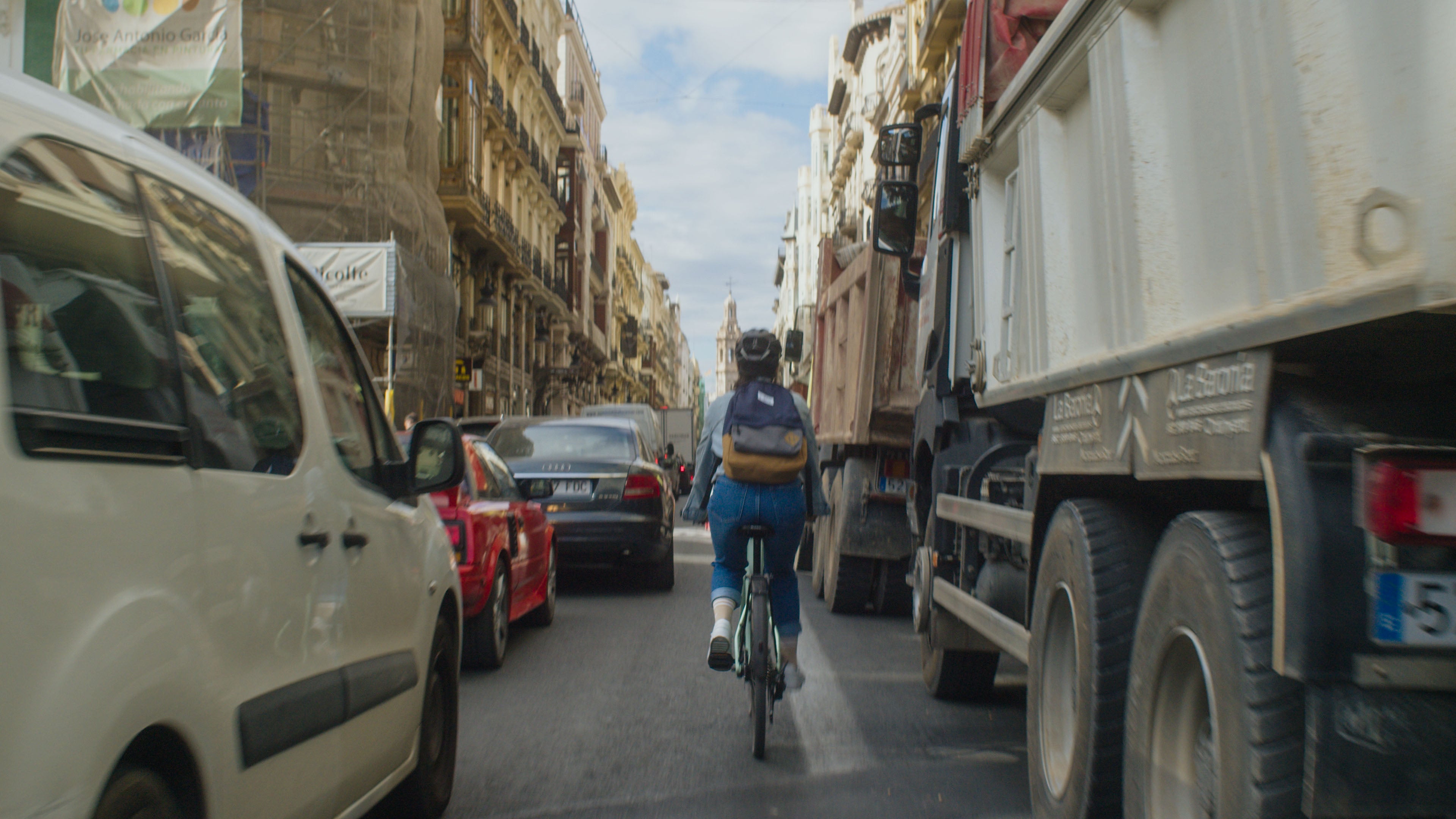How new bike technology could help cyclists tell drivers not to crash into them
Bikes are starting to communicate with cars, in the hope of minimising crashes. But will it work and get more people on bikes – or could it actually endanger cyclists, asks Andrew Griffin


Kirkpatrick Macmillan, a Scottish blacksmith, may have been the first to invent the pedal-driven bicycle, when in about 1839 he attached a treadle like that on an old sewing machine to a hobby horse and made it possible to pedal. Then, about three years later, he set out on a journey that might have been another first: he left his home in Dumfries and Galloway, pedalling 130 miles to visit family in Glasgow, where a crowd gathered to watch. In the confusion, Macmillan knocked over a child, and was fined five shillings for doing so.
Ever since the bicycle was invented, accidents have followed closely behind. (It is not clear whether Macmillan really was the “gentleman from Dumfries-shire bestride a velocipede of ingenious design”, described in a contemporaneous newspaper article, who caused the incident in the Gorbals.) Nearly 200 years on, bikes have improved at an astonishing rate – but not always in ways that have kept people safe.
In recent years, however, new technology has joined the humble helmet in an attempt to avoid bike crashes and reduce injuries when they do. Innovations allow cyclists to know where drivers are, even if they can’t see them; and upcoming products will make that more broadly possible, letting bikes and cars talk to each other with the hope it will stop them colliding. Proponents hope that new technology will make cycling safer, allowing more people to get out on bikes and, among other things, help the environment. But some fear that the technology, if not properly implemented, could actually make cyclists less safe on the roads.
At the end of 2021, Joe Biden signed the Infrastructure Investment and Jobs Act into law. Best known as the Bipartisan Infrastructure Bill, it included about $1.2 trillion in spending, with most of it being spent on roads, bridges and new power infrastructure. But it also included a commitment to research the ways that “bicyclists and other vulnerable road users” can be considered as part of the introduction of “connected vehicle systems”.
That relates to the introduction of “intelligent transport systems”, or ITS, which looks at adding new information and communication technologies into all parts of travel: by planting beacons in them, everything from cars to lamp posts can talk to each other, and ensure they all know where the others are. This happens already: millions of cars have a system called “eCall”, which lets the car call emergency services in an accident, and mapping software like those from Apple and Google monitors where other cars are to find traffic hotspots and route people around them.
For the most part, however, that technology has avoided cyclists and other vulnerable road users. But as the US infrastructure bill made clear, they need to be considered in the introduction of those technologies. And now companies are finally getting round to it: bike company Canyon recently announced that it would be integrating technnology from Autotalks, with a view to selling bikes with it in by 2026.
Autotalks makes “V2X”, or "vehicle-to-everything" communication systems. It means, in short, that bikes and cars will be able to talk to each other, turning bikes into beacons. Transmitters in the bikes will shout to other vehicles and infrastructure, alerting them that a bike is nearby so that they can stay safe. That information can then show on the dashboard, for instance: telling a driver to take care at an upcoming junction. Canyon says the system should make it easier for cyclists to be noticed, increase their safety, and make people more confident. Receivers are already available in some cars – about a million European cars have it, and 20,000 roadside units are equipped – and the number is increasing all the time.
To integrate it into bikes, manufacturers will need to add a transmitter and receiver, and maybe a display, though that could be a mobile phone. The bike industry needs to produce a profile for bikes so that cars can recognise what they are, and vice versa. Bike companies will also have to make sure the receivers can be integrated securely, and withstand the weather and other wear that happens to bikes when they are used for commuting.
The hope is that the technology can help drivers avoid accidents. Drivers can be alerted that a cyclist is crossing a junction, or is hidden behind a larger vehicle. In the future, Canyon suggests that cars could automatically respond to that information – automatically having their speed reduced or doors locked to avoid opening onto a cyclist – and the helpfulness of such beacons in a future of self-driving vehicles is obvious.
All of that should help get more people on bikes, Canyon hopes. Even as the number of cycle commuters has grown, they have been held back by the fear that they could be injured or killed by a driver.
“Road safety and the perception of danger is one of the primary reasons customers state for not cycling,” says Lionel Guicherd-Callin, Canyon’s global director of connected technologies. "You only have to look at cycle rates in places like Belgium or the Netherlands, where there are thousands of traffic-free paths, and places like the UK, where cycle path provision is significantly less, to see that the perception of safety is an overriding factor.
“So the more steps we can take to reduce those barriers, the safer the situation can be for all road users.”
Some technology has already been developed to give cyclists a better sense of where cars are. Garmin, for example, offers a bike radar that mounts to the back of a bike and can see cars from a mile away, alerting cyclists if a vehicle appears to be coming behind them quickly.
That joins other tools such as bike tracking so that friends and family can see where a bike is in the event of crash or other problem, which is already offered by other cycle brands, including those from Canyon. Bicycles are gradually turning into computing devices, full of connections, trackers, sensors and more besides. “Bikes are getting smarter and more inter-connected to our personal eco-systems, which makes them smarter and adds extra value or enjoyment for the customer,” says Guicherd-Callin.
“Riding in traffic is a cause of anxiety for a lot of people, whether they cycle regularly or not. For people who live in towns and cities, it can be difficult to reach traffic-free places without cycling in traffic. So the more that can be done to be ‘seen’, the greater the chance of reducing that anxiety. V2X is a very promising technology to change the game and preventing ‘dooring’ accidents and reduce the ‘Sorry mate, I didn’t see you’ excuse by covering drivers’ blind spots.
“If we want to reduce our carbon emissions, we need more urban citizens to drop their cars for more environmentally friendly ways of transportation. Bikes have a very important role to play here.”
But some worry that the technology will actually make things less safe for cyclists who choose not to install a transmitter on their bike, for reasons of cost, privacy or anything else. Bikes that do not have beacons could be practically invisible. ‘Sorry mate, I didn’t see you’ might become ‘Sorry mate, my receiver didn’t see you’ – and if the cars are driving themselves, then there might not even be a human behind the wheel to make that excuse.
There are a whole host of other concerns, too. Anything connected – including a bike – is a cybersecurity risk, and it is not difficult to imagine how a malicious hacker might cause chaos by taking over a road system. What’s more, the expectation that anything on or around the road will show up as a beacon could be disastrous for pedestrians, who might either be forced to have beacons of their own or face yet more danger.
Still, bike accidents are happening now, and mostly because drivers fail to spot cyclists. Figures from the UK show that drivers failing to see cyclists remains the biggest danger to their life. In serious and fatal collisions, the most “common contributory factor” was that “driver or rider failed to look properly”. The same figures show that between 2004 and 2021, pedal cyclist traffic grew by 62 per cent, while fatalities fell by 17 per cent, though serious injuries were up 27 per cent.
Work will be needed to ensure that new technology helps avoid those dangers, not simply move them around. That work seems to be happening. US, European and UK governments among others all already have work ongoing to research V2X and the opportunities and dangers that it might provide. Car, bike and communication companies are working together with a view to ensuring the technology is rolled out and can speak to each other.
Kirkpatrick Macmillan and his unusual-looking bike have slipped mostly into history. But road users will be hoping that the major companies that have inherited his “ingenious design” will be learning from his work to empower vulnerable road users through the bike, not the crash that a couple of years later imperilled them.
Join our commenting forum
Join thought-provoking conversations, follow other Independent readers and see their replies
Comments
Bookmark popover
Removed from bookmarks